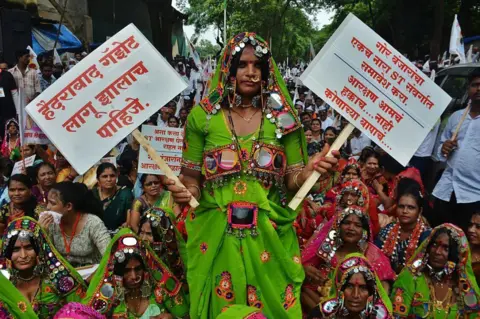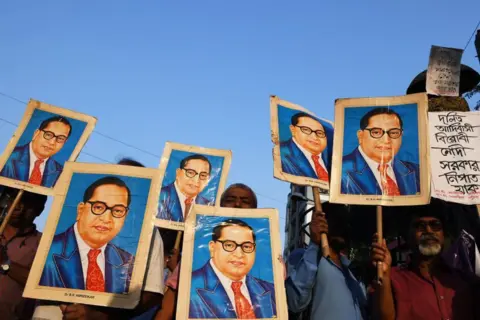Soutik BiswasIndia correspondent
 Praful Gangurde/Hindustan Times via Getty Images
Praful Gangurde/Hindustan Times via Getty ImagesCounting castes in India has always been about more than numbers – it is about who gets a share of government benefits and who doesn’t.
The country’s next national census, scheduled for 2027, will – for the first time in nearly a century – count every caste, a social hierarchy that has long outlived kingdoms, empires and ideologies. The move ends decades of political hesitation and follows pressure from opposition parties and at least three states that have already gone ahead with their own surveys.
A 2011 survey – neither run nor verified by census authorities or released by the government – recorded an astonishing 4.6 million caste names.
A full count of castes promises a sharper picture of who truly benefits from affirmative action and who is left behind. Advocates say it could make welfare spending more targeted and help recalibrate quotas in jobs and education with hard evidence.
Yet in a provocative new book, The Caste Con Census, scholar-activist Anand Teltumbde warns that the exercise may harden the deeply discriminatory caste system, when the need is to dismantle it.
The argument cuts against the prevailing view that better data will produce fairer policy. For Mr Teltumbde, castes are “too pernicious to be managed for any progressive purpose”.
“Caste is, at its core, a hierarchy seeking impulse that defies measurement,” he writes.
Mr Teltumbde sees the modern caste census as a colonial echo.
British administrators began counting castes in 1871 as a “deliberate response to the post-1857 unity of Indians across caste and religion”, turning it into an “effective tool of imperial control”. They held six caste censuses between 1871 and 1931 – the last full caste enumeration in India.
Each count, Mr Teltumbde argues, “did not merely record caste, but reified and hardened it”.
Independent India, in Mr Teltumbde’s reading, preserved the system under the moral banner of social justice, “while effectively evading its core obligation of building the capacities of all people, which is a prerequisite for the success of any genuine social justice policy”.
The obsession with counting, he says, bureaucratises inequality. By turning caste into a ledger of entitlements and grievances, the census reduces politics to arithmetic – who gets how much – rather than addressing what Mr Teltumbde calls the “architecture of social injustice”.
He sees the demand for a caste census as a push for more reservations – a cause driven by an “upwardly mobile minority”, while the majority slips into deprivation and dependence on state aid. Nearly 800 million Indians, he notes, now rely on free rations.
 Fairfax Media via Getty Images
Fairfax Media via Getty ImagesAffirmative action quotas were first reserved for Dalits – formerly known as untouchables – and Adivasis (tribespeople), India’s most oppressed groups. But soon, the less disadvantaged “other backward classes” (OBCs) began clamouring for a share of the pie. Politics quickly coalesced around demands for new or bigger caste-based quotas.
Mr Teltumbde’s deeper worry is that enumeration legitimises what it measures. Political parties, he warns, will exploit the data to redraw quotas or convert caste resentment into electoral capital.
For Mr Teltumbde, the only rational politics is one of “annihilation of caste”, not its management – echoing what BR Ambedkar, the architect of India’s constitution, argued when he said that caste cannot be reformed, it “must be destroyed”.
But in an India where even its victims “see value in its preservation”, that goal feels utopian, the author admits. The looming caste census, Mr Teltumbde argues, will not expose inequality but entrench it.
Many scholars don’t quite agree, seeing the census as a necessary tool for achieving social justice.
Sociologist Satish Deshpande and economist Mary E John call the decision not to count castes “one of independent India’s biggest mistakes”.
Today, they note in a paper, caste has come to be seen as the burden only of India’s lower castes – Dalits and Adivasis – who must constantly prove their identity through official labels.
What’s needed, they write, is “a fuller, more inclusive picture where everyone must answer the question of their caste”. This isn’t an “endorsement of an unequal system”, they stress, but a recognition that “there is no caste disprivilege without a corresponding privilege accruing to some other caste”.
In other words, the lack of reliable caste data obscures both privilege and deprivation.
Sociologist and demographer Sonalde Desai told me that without a fresh caste census, India’s affirmative action policies operate “blindly”, relying on outdated colonial data.
“If surveys and censuses could shape social reality, we would not need social policies. We could simply start asking questions about domestic violence to shame people into refraining from wife-beating. We have not asked any questions in the census about caste since 1931. Has it eliminated caste equations?” she asks.
 AFP via Getty Images
AFP via Getty ImagesPolitical scientist Sudha Pai, however, broadly agrees with Mr Teltumbde’s critique that counting castes can solidify identities and distract from deeper inequalities based on “land, education, power and dignity”.
Yet she acknowledges that caste has already been politicised through welfare and electoral strategies, making a caste census inevitable.
“A caste census would be useful if the income levels within each caste group are collected. The government could then use the data collected to identify within each caste the needs of the truly needy and offer them the required benefits and opportunities, such as education and jobs for upward mobility,” Dr Pai says.
“This would require moving away from simply using caste as the parameter for redistribution of available resources, to use of both caste and income levels in policymaking.”
Dr Pai argues that if done “thoughtfully” – linking caste data to income and educational indicators – it could shift India from a “caste-based to a rights-based welfare system”.
Yet, scholars warn that counting castes and interpreting the data will be fraught with challenges.
“It won’t be painless. India has changed tremendously in the century since 1931. Castes that were designated as being poor and vulnerable may have moved out of poverty, some new vulnerabilities may have emerged. So if we are to engage in this exercise honestly, it cannot be done without reshuffling the groups that are eligible for benefits,” says Professor Desai.
Another challenge lies in data collection – castes have many subgroups, raising questions about the right level of classification. Sub-categorisation aims to divide broader caste groups into smaller ones so the most disadvantaged among them receive a fair share of quotas and benefits.
“Castes are not made of a single layer. There are many subgroups within a single caste. What level of aggregation should be used? How will the respondents in a census respond to this question? This requires substantial experimentation. I do not believe this has yet been done,” says Prof Desai.
Mr Teltumbde remains unconvinced. He argues that endless enumeration cannot remedy a system built on hierarchy.
“You will be counting all your life and still not solve the caste problem. So what will be the use of that counting?,” he wonders. “I am not against affirmative action, but this is not the way to do it.”

